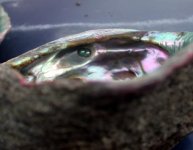Ah! Caught it just in time! Just as it was about to slip away to page 2!
There was a ridge, about 62mm long, in one of my shells. It looks as though the abalone squeezed together part of the inside of the shell and it formed a protruding fold. (Pix 1, 2 % 3) I thought that it might be somehow similar to the "wing pearls" that NZNP posted earlier. I cut it out and began to grind off the back, expecting to find nothing more than empty space, conchiolin and perhaps the remains of a parasite in the middle. I was using a very aggressive wheel and ground through the back and a layer of conchiolin and then about one mm into another layer of shell. (ouch!)(fourth photo) What I found didn't make a lot of sense at first so I carefully scraped out some of the conchiolin and realized that what I had seemed to possibly be an imbedded pearl! (last photo) It is a very odd shape and I began to think that it enclosed something on the order of a small fish or other creature. However, it didn't have any obvious separation from the shell on one side. I took it down to a friendly local dentist and got his assistant to X-ray it. It's interior is a puzzle at best. No fish that I could find and some very odd forms internally. The X-ray is too dark to scan so will try to photo it with light coming through it later. There is a suture line that seems to separate part of it from the other--can't tell to what extent, yet. I figured out that the side that doesn't seem to have a separation from the shell forms a sort of flange that is sandwiched between the inside and outside shell layers and I cut through it in cutting the whole thing out of the shell. It's kind of like it was a bit of pastry dough that was squeezed out and them squeezed down and stretched out thin on one side. Go figure. . . I'm not sure what to do with it at this point. I'll have to give it careful thought. The inside pearl (?) measures about 60mm in length.














